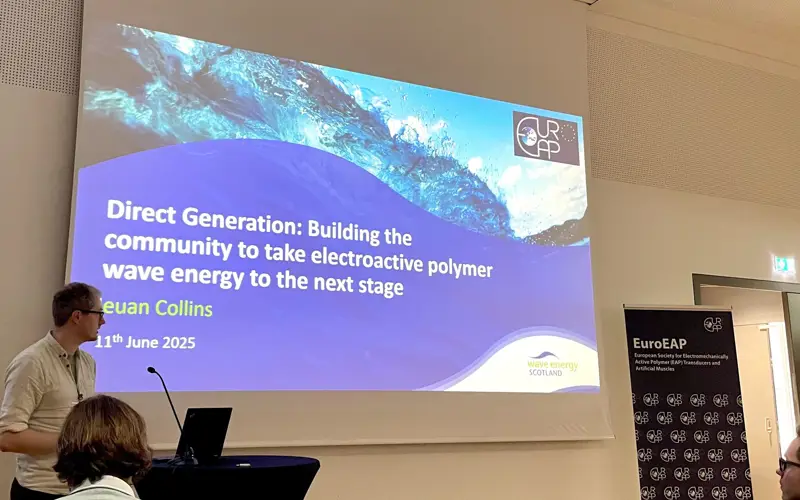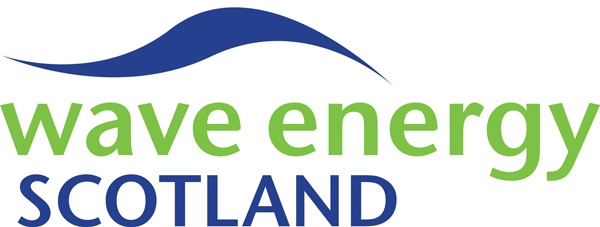
Stretching the limits: how Direct Generation technologies could power the future
1. Introduction
Wave energy systems are advancing toward commercial viability, bolstered by their synergy with floating offshore wind and the growing appetite for diverse renewables. However, further improvements to cost and performance could be achieved through next generation innovations that could deliver improvements beyond the constraints of conventional generator technologies. Direct Generation (DG) systems—particularly Dielectric Elastomer Generators (DEGs) and Dielectric Fluid Generators (DFGs)— may present a promising pathway for such a step change.
2. The Case for Direct Generation Technologies
DG technologies offer a more streamlined approach to wave energy conversion, bypassing intermediary mechanical or hydraulic stages by directly transforming mechanical strain into electrical energy. In contrast, traditional power take-off (PTO) systems rely on these conventional conversion steps, which can introduce added complexity and potential efficiency trade-offs. Wave Energy Scotland (WES) performed a comprehensive down-selection process of Direct Generation technologies through a funded Frazer-Nash study and University of Edinburgh PhD. Among all the technologies investigated, variable-capacitance electroactive polymers—particularly dielectric elastomer generators (DEGs) and dielectric fluid generators (DFGs)—have shown significant promise. These technologies offer simplified architectures, fewer components, and potentially more favourable cost-to-performance ratios.
Since DEGs and DFGs comprise of polymers, this could present a more cost-effective approach to constructing wave energy converters. Moreover, they open the door to a radically different cradle-to-grave design philosophy. For instance, a wave energy device could be composed of DEG/DFG-based cellular building blocks, manufactured through a roll-to-roll process by a single supplier. This approach mitigates supply chain challenges and enables scalability that is independent of the WEC's shape or size. Polymers can also be engineered with recyclability in mind, including the ability to biodegrade or be recycled and repurposed into a new wave energy converter at the end of their service life—delivering compounding cost savings over time.
3. How DEGs and DFGs Work
Imagine a flexible structure composed of alternating layers of conductive electrodes and insulating dielectric materials—together forming what's known as a metamaterial. When opposite charges are applied to the electrodes, the system behaves like a capacitor, storing electrical energy. The crucial parameter here is capacitance: the material’s ability to hold charge relative to the applied voltage.
As wave motion causes the structure to twist, bend, or stretch, the spacing between the electrodes continuously shifts. These deformations lead to dynamic changes in capacitance, which can be harnessed throughout each mechanical cycle. This allows the metamaterial to generate and store electrical energy in response to motion.
Of interest for wave energy are two topologies:
• Dielectric Elastomer Generators (DEGs): Consist of an elastomeric film sandwiched between two compliant electrodes. Mechanical deformation (stretching, bending) alters the film’s capacitance. Electrical cycles applied at minimum and maximum capacitance points enable energy harvesting via charge pumping.
• Dielectric Fluid Generators (DFGs): Enclosed cells filled with dielectric liquid, also using deformable electrodes. Capacitance variation is achieved through motion-induced compression or displacement of the liquid medium, with an analogous charge cycle to DEGs.
4. Technology Acceleration: The WES Competition and R&D Programme
To comprehend this opportunity, WES applied a two-prong approach with a development and research component. This involved a mixture of innovation methods and experimental research.
Round 1 – Concept Generation (14 weeks: 2023-2024)
Towards the end of 2023, WES launched a design competition to stimulate innovation in early-stage DG technologies, encouraging inventive problem-solving and structured down-selection.
Participants:
• 4c Engineering – DFG
• TTI Marine Renewables – DEG
• AWS Ocean Energy – DEG
• University of Southampton/Nottingham – DEG/DFG
• WaveX – DEG/DFG
Key outcomes:
Teams produced conceptual designs and performed technical evaluations of various configurations. The iterative design process identified critical R&D priorities, leading to the development of an initial Research Agenda.
Round 2 - Feasibility & Prototyping (9 months: 2024–2025)
In the summer of 2024, following on from the first phase, WES launched a longer more detailed second phase which aimed to analyse the feasibility and begin earlier prototyping of the technology. The Round 1 participants were down selected to two teams following an application and evaluation process:
• 4c Engineering
• TTI Marine Renewables
Focus areas:
Detailed investigations were conducted across materials development, power electronics, advanced manufacturing techniques, and a preliminary fatigue analysis.
5. Highlights from Ongoing Development
The design competition produced a number of collaborations and with much of this work ongoing:
4c Engineering (DFG):
• Partnered with University of Trento to co-develop a 35-cell test rig. This work is now being continued through a dedicated PhD project.
• Validated DFG operation and initiated spinout company—Ebb Flow Energy Ltd.
• Participated in the US DOE InDEEP Prize and TechX Accelerator programme
• Demonstrated compatibility with off-the-shelf power electronics solutions.
TTI Marine Renewables (DEG):
• Applied hydrodynamic numerical modelling to evaluate structural loads which informed an experimental fatigue testing campaign.
• Collaborated with Wacker Chemie AG, ACE Laboratories, and Endurica on materials development and lifecycle testing.
• Expanded into new applications, including electroactive polymer-based mooring sensors.
• Initiated a follow-up project through the Scotland CAN DO Offshore Wind Innovation – Feasibility Challenge, supported by Scottish Enterprise, investigating synergies with offshore wind technologies.
6. Academic and Collaborative R&D
In parallel with the Design Competition, WES has co-funded several targeted academic initiatives to accelerate foundational research in direct generation technologies. WES has co-funded two 12-month Supergen ORE Impact Hub FlexFund projects led by Oxford University and Manchester University. These include two 12-month Supergen ORE Impact Hub FlexFund projects—led by Oxford University and Manchester University—and a jointly funded four-year PhD programme with EPSRC, delivered through Swansea University.
Origami DFGs (Oxford & Plymouth):
• Developed rigid-motion-based cellular architectures inspired by origami structures to overcome the challenges associated with stretchable electrodes.
• Built multiphysics models and validated performance through physical demonstrators
• Progression into a follow-up PhD project to optimise geometry and scalability.
Conductive Elastomer Nanocomposites (University of Manchester):
• Developed layered elastomer composite with conductive nanoparticles layers acting as electrode.
• Targeted improved mechanical-electrical integration and enhanced durability under operational stress.
• Synthesised and characterised stretchable electrode/elastomer composites, comparing to existing state-of-the-art configurations.
Electro-mechanical Fatigue Studies (Swansea University):
• Developing ‘in-house’ dielectric elastomers informed by experimental campaign.
• Evaluating the uniaxial/biaxial fatigue in DEG/DFG systems.
• Delivering data to guide material selection and inform fatigue modelling frameworks.
7. Recent Event and Future Opportunities
Through workshops, dissemination events (e.g., All Energy, IOM3, EuroEAP), and academic-industry collaboration, WES continues to foster development. Current funding calls—such as the Clean Energy Transition Partnership (CETP)—offer significant opportunity for scale-up.
8. Conclusion
Dielectric Elastomer and Fluid Generators represent a potentially transformative shift in how energy can be harvested from ocean waves. By combining material science, systems engineering, and innovation ecosystems, DEGs and DFGs are no longer conceptual—they’re progressing rapidly toward practical application, with the potential to redefine energy generation in marine environments. With these programmes now yielding valuable insights, WES will be analysing the emerging data to guide its next strategic direction.
